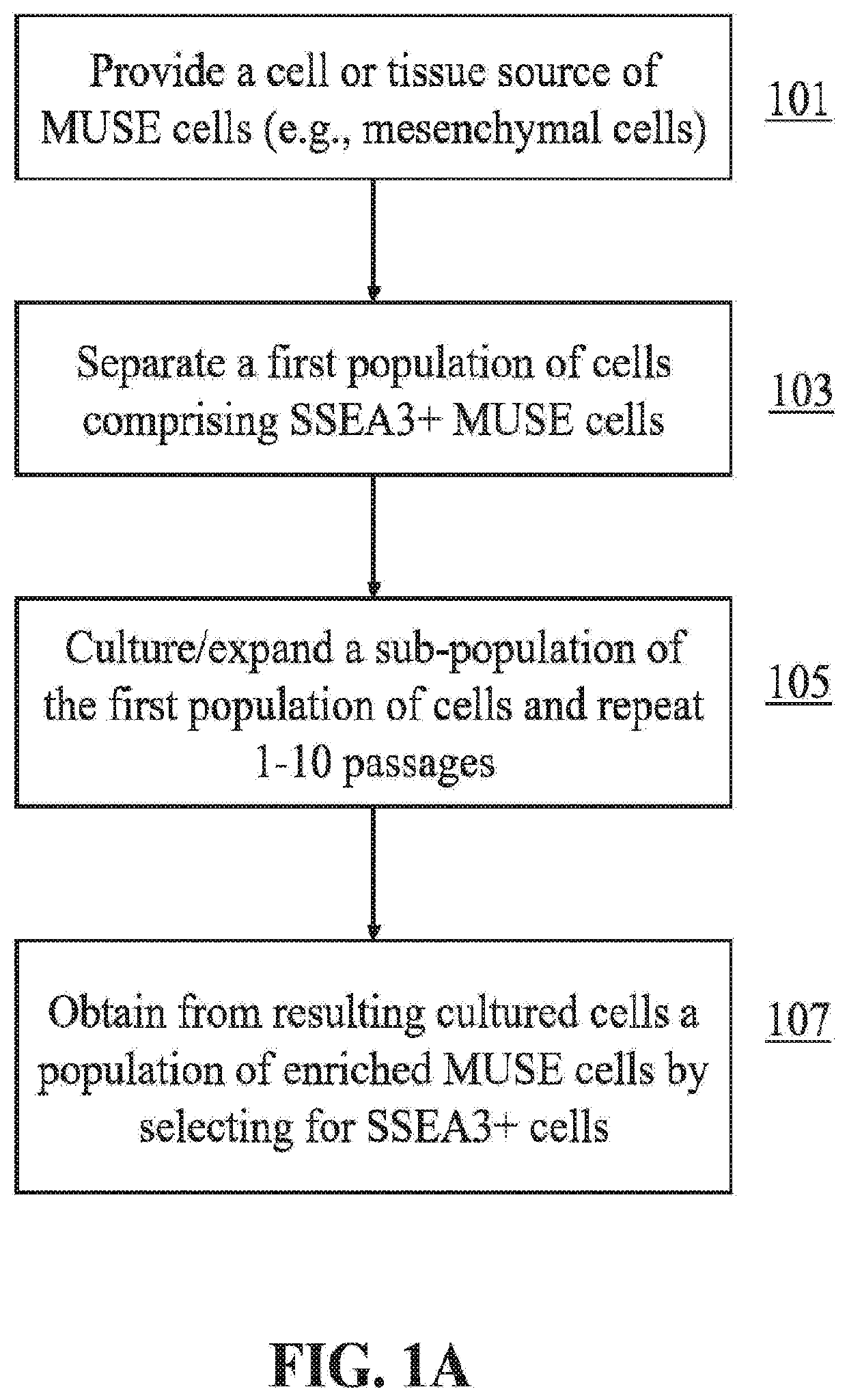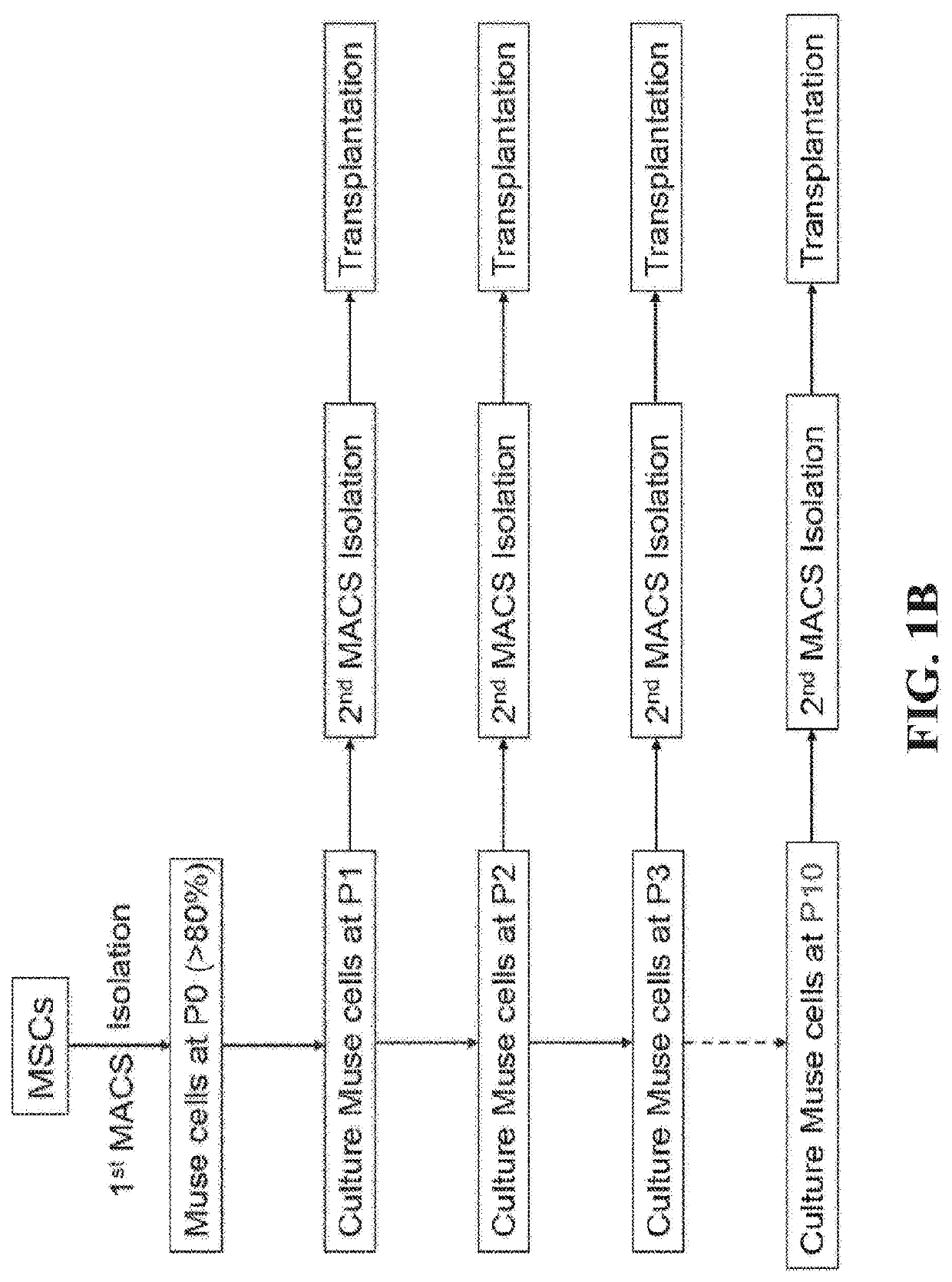Methods for enriching populations of cells
a cell population and cell technology, applied in the field of cell population enrichment, can solve the problems of inefficiency of methods, high cost, and invariably low percentage of muse cells
- Summary
- Abstract
- Description
- Claims
- Application Information
AI Technical Summary
Benefits of technology
Problems solved by technology
Method used
Image
Examples
example 1
[0087]This example describes the materials and methods to be used in the subsequent examples.
Isolation of HUC MSCs
[0088]HUC was packed in a bottle filled with the transport medium, which included KH2PO4 (0.20 g / L), Na2HPO4 (anhydrous, 1.15 g / L), KCl (0.20 g / L), and NaCl (8.00 g / L). The bottle was surrounded by ice to maintain it at 4° C. All the cords were collected with the patients' consent that fulfilled the requirements of the Rutgers University Ethics Committee. The shipment took one day from the patient to the lab. Table I lists the antibodies used in this study.
[0089]The isolation of human umbilical cord (HUC) MSCs followed a protocol described as follows. First, the HUC was placed in a 10-cm dish. The HUC was then cut into smaller 1-cm pieces and incised longitudinally. Next, the HUC artery and vein were removed, and the HUC tissues were cleaned, followed by separating Wharton's jelly and cord lining tissues. The tissues were treated with collagenase, and the cells were seed...
example 2
[0096]Both HUC WJ and CL yielded large numbers of MSCs. Table II showed the number of MSCs and SSEA3+ at Passage 0. The concentrations of MSCs and SSEA3+ cells per gram of tissue had an average of 3.7±0.55×104 WJ-MSCs, 1.89±1.67×103 WJ-SSEA3+, 3.00±0.80×104 CL-MSCs, and 2.24±2.00×103 CL-SSEA3+ cells per gram. Heavier cords had more WJ MSCs (R2=0.64, p=0.01<0.05, FIG. 4). The 99WJ group had unusually high 42.37% SSEA+ cells at Passage 0. However, cord weight did not correlate with CL-MSCs / WJ-SSEA3+ / CL-SSEA3+. Numbers of WJ-MSCs did not correlate with CL-MSCs or WJ-SSEA3+. Neither between CL-MSCs and CL-SSEA3+.
[0097]WJ and CL cells were cultured separately, and SSEA3+ percentage over multiple passages were compared (see FIG. 5). In the P0 group, more than 98% of the total cells from both WJ and CL were CD105 positive and even higher in P1 and P2. At P0, the percentages of SSEA3+ cells were 4.97%±4.30% and 5.26%±5.14% in WJ and CL, respectively. However, SSEA3+ percentages dropped shar...
example 3
[0102]The HUC SSEA3+ and CD105+ cells were transplanted into the spinal cords of two adult Sprague-Dawley rats at 2 weeks after spinal cord injury (SCI) with a 12.5-mm weight drop contusion of the T11 spinal cord. The cells were injected into the dorsal root entry zone of the spinal cords above and below the injury site. The cells survived for 4 weeks after transplantation. The rats were not immunosuppressed. The transplanted cells were stained with an antibody for human nucleus (Stem 101+) but were otherwise negative for Nestin, GFAP, NeuN, NF155, and Iba1. When transplanted into brain and spinal cord, human MUSE cells survive for long times and are not immune-rejected (Uchida H, et al. Stem Cells. 2016; 34(1):160-173; Uchida H, et al. Stroke. 2017; 48(2):428-435).
PUM
 Login to View More
Login to View More Abstract
Description
Claims
Application Information
 Login to View More
Login to View More - R&D
- Intellectual Property
- Life Sciences
- Materials
- Tech Scout
- Unparalleled Data Quality
- Higher Quality Content
- 60% Fewer Hallucinations
Browse by: Latest US Patents, China's latest patents, Technical Efficacy Thesaurus, Application Domain, Technology Topic, Popular Technical Reports.
© 2025 PatSnap. All rights reserved.Legal|Privacy policy|Modern Slavery Act Transparency Statement|Sitemap|About US| Contact US: help@patsnap.com



